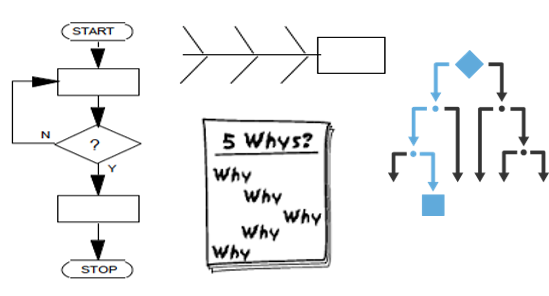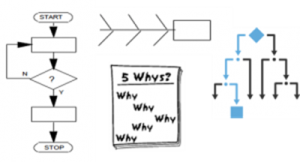
There are two kinds of problem solving in the medical device world:
1 – Solving for improvements in effectiveness and efficiency
2 – Solving for corrective action/preventive action (CAPA) compliance
The transition from #1 to #2 seems to perplex organizations entering the medical device arena for the first time. CAPA is too often seen as a burden, stealing valuable time from scientists and engineers who would rather focus on what they know best – designing and making new products.
Ironically, many of these same wannabe medical device companies have a robust Lean and Six Sigma culture, where a large percentage of employees hold Green Belts. However, even these companies struggle with translating their best practices for problem solving into the world of CAPA.
So how do you evolve a robust Lean and Six Sigma culture dominated by Green and Black Belts to a culture that also embraces CAPA? Based on extensive training and coaching work we have done with such organizations, below are the factors that, when addressed, lead to success. Think of them as the first steps to a “Red Belt” for CAPA owners who investigate and solve compliance-critical CAPA-related problems.
There are two kinds of problem solving in the medical device world:
1 – Solving for improvements in effectiveness and efficiency
2 – Solving for corrective action/preventive action (CAPA) compliance
The transition from #1 to #2 seems to perplex organizations entering the medical device arena for the first time. CAPA is too often seen as a burden, stealing valuable time from scientists and engineers who would rather focus on what they know best – designing and making new products.
Ironically, many of these same wannabe medical device companies have a robust Lean and Six Sigma culture, where a large percentage of employees hold Green Belts. However, even these companies struggle with translating their best practices for problem solving into the world of CAPA.
So how do you evolve a robust Lean and Six Sigma culture dominated by Green and Black Belts to a culture that also embraces CAPA? Based on extensive training and coaching work we have done with such organizations, below are the factors that, when addressed, lead to success. Think of them as the first steps to a “Red Belt” for CAPA owners who investigate and solve compliance-critical CAPA-related problems.
Management support is a linchpin of Lean and Six Sigma culture. Staff are often required each year to propose and execute a Green Belt project tied to a key performance indicator (KPI). While that’s admirable and can produce positive gains in efficiency, senior management usually doesn’t attach that same level of importance to CAPA. This lack of senior management support has a negative trickle-down effect in the organization – those charged with researching, implementing, and closing CAPAs often find internal cooperation in short supply. As a result, CAPAs take longer to close than they should, putting the company at risk.
Management needs to view CAPAs as an opportunity instead of a burden and treat them with the same respect and urgency as problem solving for improvement. After all, isn’t keeping your products in compliance and on the market the most important KPI of all? It won’t matter if you’ve figured out how to get a 5% improvement in manufacturing efficiency if you don’t have a product to sell.

Problem-solving tools need to be embedded in the systems and culture of the company. Everyone from the shop floor to the C-suite needs to use the same language and tools. Our training class in root cause investigation is a great way to begin building this problem-solving culture. Start with just a few tools in which everyone becomes proficient and make sure those same tools are used for Lean Six Sigma and CAPA. One excellent tool commonly used in the Six Sigma world is the project charter. It is goal-focused and allows problem-solving teams to get visibility and valuable resources from management early on. Why? Because the charter requires teams to “define” the resources needed to achieve goals. In CAPA land, that’s usually not part of the process.
Next develop a strong problem statement that is grounded in data. These data are used in the CAPA effectiveness verification stage to ensure that the solution closed the gap. A great tool for problem definition is the “Is/Is Not” table, because it helps refine and scope a problem by asking where the problem could also have occurred. Many of us are familiar with the 5 Whys and fishbone (Ishikawa) tools applied during the investigation or DMAIC’s Analyze phase, but often teams employ a tool and feel as if they’re trying to fit a square peg into a round hole. That’s a sure sign that the team is working for the tool rather than the tool working for the team. We recommend using a progression of tools that makes it easier to move between tools.
Of course, in CAPA the most important tool is good documentation, written with the audience in mind. Who’s the audience? Not just auditors and regulators, but also management, peers, and even the future. The A3 form from the Lean and Six Sigma toolbox is a great documentation tool when augmented with written summaries. The key is to document as you go, not make it a check-the-box activity after the investigation when you’re trying to remember the problem-solving process.
Green Belt teams get high fives, t-shirts, and donuts after successfully completing a project. CAPA teams get cold coffee and a cold shoulder. Instead of being lauded for the problems they have solved or issues they have brought to light, team members are often dinged for being late, being ineffective (due to lack of internal support), or missing deadlines on other projects. That’s a shame because CAPA is really a critical part of a company’s process improvement ecosystem and it needs to be taken more seriously. This is especially true with the impending implementation of the new European Medical Device Regulation (MDR) in 2021.
For medical device companies, the EU MDR shines a spotlight on risk management along with clinical evaluation and postmarket surveillance. These are all regulatory compliance areas that – if not taken seriously by the management team – can result in losing access to the European market. The CAPA process integrates with all of these processes.
Oriel STAT A MATRIX has been helping medical device professionals with quality and regulatory compliance for decades. Our consultants can work with you to assess the effectiveness of your CAPA program and train your team on optimizing the program’s effectiveness.

US OfficeWashington DC
EU OfficeCork, Ireland



UNITED STATES
1055 Thomas Jefferson St. NW
Suite 304
Washington, DC 20007
Phone: 1.800.472.6477
EUROPE
4 Emmet House, Barrack Square
Ballincollig
Cork, Ireland
Phone: +353 21 212 8530